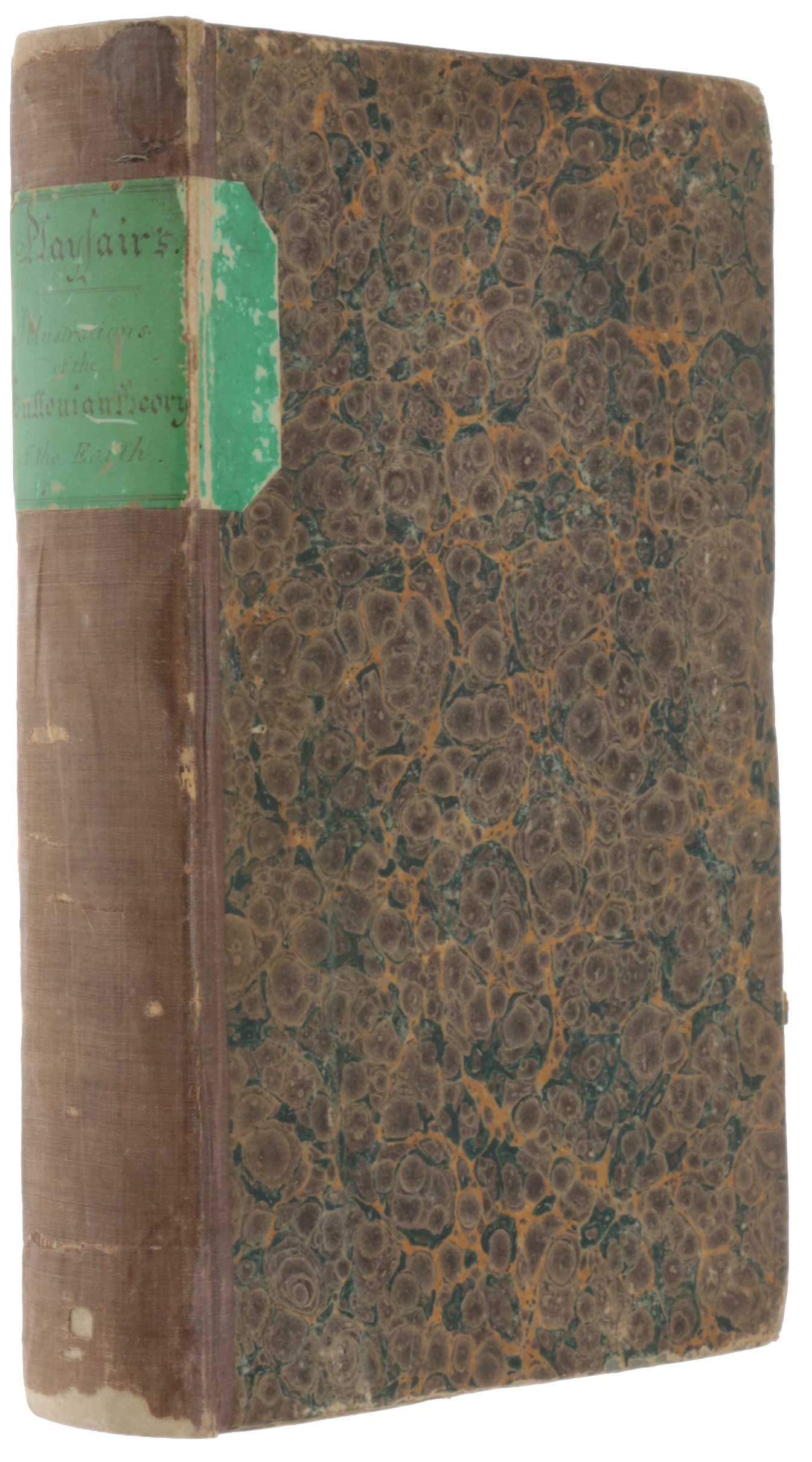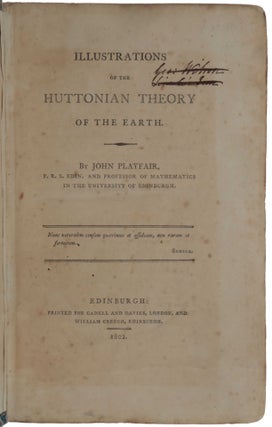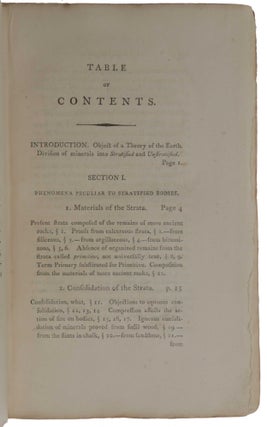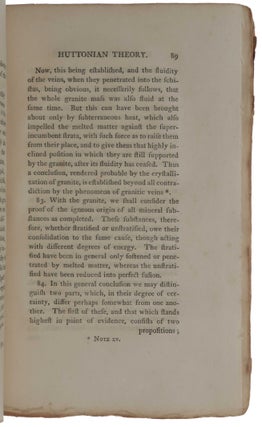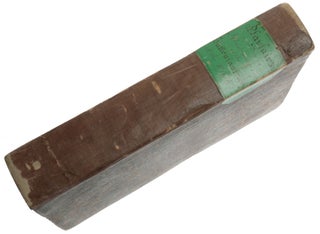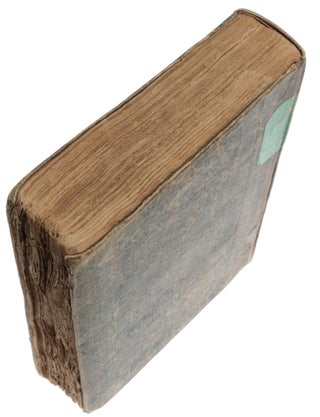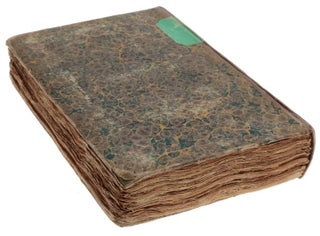Illustrations of the Huttonian Theory of the Earth.
Edinburgh: [Neill & Co. for] Caddell and Davies; William Creech, 1802. First edition of “one of the most conspicuous landmarks in the progress of British geology” (DSB). “Of this great classic it is impossible to speak too highly. For precision of statement and felicity of language it has no superior in English scientific literature.” (Evans). Playfair (1748-1819) was Professor of Mathematics at Edinburgh from 1785 to 1805. In 1795 he published an important edition of Euclid, containing an original formulation of the fifth postulate. “Playfair’s fame as a scientist, however, rests almost entirely on his work in geology —hardly a “professional” study at the time — in presenting Hutton’s momentous theory in a clear and palatable form (which Hutton himself had failed to do), and in adding materially to the geological knowledge of the time” (DSB). “Playfair’s exposition and development of James Hutton’s Uniformitarian theory of the earth was largely responsible for the theory’s acceptance. Playfair believed Hutton’s theory to be a qualitative revolution in thought — the geologic equivalent of Newton’s Principia — but felt that its scientific principles were too much obscured by Hutton’s difficult prose and preoccupation with natural theology. Divorcing Hutton’s science from his religious ideas, Playfair presented the essential elements of Uniformitarianism in a clear, elegant and readable manner, reinforcing them with many original observations and reflections of his own. He recognized the importance of unconformity (lack of continuity between strata in contact) as a manifestation of the geological cycle, a concept at the heart of Hutton’s theory. He provided many descriptions of unconformities in England and Scotland, and made several important miscellaneous observations as well. Playfair also gave many terms their modern geological meaning, and introduced important new phrases, such as “geological cycle,” into scientific literature” (Norman). “The world is so complex, and the skills needed to apprehend it so varied, that even the greatest of intellects often needs a partner to supply an absent skill … James Hutton, whose Theory of the Earth (1795) marks the conventional discovery of deep time in British Geological thought, might have occupied but a footnote to history if his unreadable treatise had not been epitomized by his friend, and brilliant prose stylist, John Playfair, in Illustrations of the Huttonian Theory of the Earth (1802)” (Gould, Time’s Arrow, Time’s Cycle, p. 61). “Hutton’s theory … postulated a cyclical history of the earth in four stages, consisting of erosion, deposition of the eroded land as strata at the bottom of the ocean, compression of the strata under the heat which lies beneath the earth’s crust, and the fracturing and re-emersion of the fused sediments to form new continents. The revolutionary nature of Hutton’s system lay in its cyclical view of geologic processes, in its rejection of the catastrophic view of the processes of geological evolution, and in its focus on the materials of the earth itself as adequate testimony to a continuous and uniform process of change” (DSB, under Hutton). Hutton’s theory was first made public at two meetings of the Royal Society of Edinburgh, early in 1785, and first appeared in print in condensed form as a thirty-page pamphlet entitled Abstract of a Dissertation … Concerning the System of the Earth, which Hutton circulated privately in 1785. The society published Hutton’s theory in full in “Though Playfair had probably met Hutton by 1769 (both were then in Edinburgh, enjoying the same friends) and had presumably developed some kind of rapport by 1781, the most meaningful part of their association took place during the last decade of Hutton’s life. We know, for example, that Playfair had not been privy to the details of Hutton’s theory before its presentation in 1785. On hearing that theory, moreover, he failed to see how it could explain the oblate shape of the earth — for him a necessary condition — and therefore remained sceptical of its validity. Yet, by 4 June 1788, Playfair and Hutton were visiting Siccar Point together. That year or the next, they were in Ayrshire. Sometime after 1791, Playfair wrote a geological letter about the English Lake District to Hutton, who published the major portion of it four years later. Though there must have been a good deal in Playfair’s extensive papers and correspondence regarding Hutton and his theories, we have lost this evidence entirely. “According to Plafair’s nephew, James G. Playfair, his uncle John devoted the five years from Hutton’s death in March 1797 to the publication of his Illustrations of the Huttonian Theory (1802) in preserving his friend’s thought and life. Having at first intended to summarize Hutton’s geological theory as part of a more general biographical memoir of him, … Playfair began once again to read through Hutton’s Theory, only to be appalled at how verbose and impenetrable it was. Hutton’s stylistic inadequacy, he soon came to believe, had been in large part responsible for the failure of his thinking to achieve broader acceptance. Knowing himself to be a much more gifted writer, … Playfair set aside his memoir of Hutton for a time in order to explicate the latter’s theory. “On the evening of 1 July 1799, at the Royal Society of Edinburgh, Francis Horner heard Playfair read the first part of his analysis of Hutton’s theory, “a very distinct and luminous deduction from as powerful a train of arguments as ever were given in favour of a mere hypothesis.” Playfair read his second part at the next meeting. As we have every reason to suppose, the two halves of Playfair’s presentation later became the 140-page main section of the book, which, except for one addition, must therefore have been completed by June 1799. “With wonderful economy, Playfair emphasized the fundamental simplicity of Hutton’s argument by presenting it under only three major headings. A masterful introduction began by citing three examples of fossils to prove that present land was once immersed beneath the sea; evidence derived from broken strata similarly established that “the earth has been the theatre of many great revolutions, and that nothing on its surface has been exempted from their effects” (p. 2). To trace, explain, and connect these revolutions, he believed, is the proper object of a theory of the earth. Though geology was the youngest of the sciences, many theories had already been proposed, most of them stressing either fire or water; Hutton’s, however, had both … “In conclusion, Playfair argues splendidly, the Huttonian theory is both novel and beautiful. Unlike others, it “presents us with a system of wise and provident economy, where the same instruments are continually employed, and where the decay and renovation of fossils [mineral bodies] being carried on at the same time in the different regions allotted to them preserve in the earth the conditions essential for the support of animal and vegetable life” (p. 128). Like the water cycle, it seems to demonstrate beautiful contrivance in nature. Among his many novel facts and observations, Playfair notes, Hutton calls attention to granitic veins, irregular junctions of primary and secondary strata, the distinction of whinstone from lava, the local changes in strata surrounding veins of whin, and the affinity of whinstone and granite; the universality of unlimited decay; and the sufficiency of present-day causes to explain geological phenomena (pp. 130-131). Even were a comprehensive theory of the earth beyond human capacity, these would still be valuable additions to our knowledge. Because no other includes these points, we may justly call that now before us the Huttonian theory (p. 135). “This was, in all probability, Playfair’s original ending, as read by him before the Royal Society of Edinburgh in 1799. Once the success of his presentation had become obvious, Playfair — like Hutton before him — soon began to elaborate his own remarks with a far longer section called “Notes and Additions” … Playfair seemingly began writing the latter half of his now-anticipated book during the fall of 1799” (Dean, James Hutton and the history of geology, pp. 103-8). Playfair’s notes were designed primarily to counter criticisms of Hutton’s theory made by Richard Kirwan (1733-1812) in his Geological Essays (1799). “Of Playfair’s notes — often, short essays — intended to illustrate Hutton’s theory of the earth, the first twelve (excepting the problem in note i) were pretty much orthodox attempts to explain and corroborate what Hutton actually thought. [In note i, Playfair attempts to refute Kirwan’s charge that Hutton believed all calcareous rocks to be of animate origin — but Hutton had said exactly that.] Note xiii [‘Metallic veins’], however, added an insistence on violence not found in the original. Note xiv [‘On Whinstone’], similarly, extended Hutton’s thinking on basalt, particularly in the reply to Werner, an opponent whom Hutton never mentioned. In note xv, on granite, Playfair twice specifically contradicted Hutton but claimed that the corrections made no difference to the theory. Notes xvi [‘Rivers and lakes’] and xvii [‘Remains of decomposed rocks’] are substantially Playfair’s own work. In note xviii [‘Transportation of stones, etc.’], Playfair’s understanding of glaciers goes beyond Hutton’s. His mathematical argument for the carrying power of streams, moreover, has no Huttonian equivalent. Hutton had supposed detritus from the land to reach the middle of the ocean primarily through the action of waves. Like Deluc in 1790 Kirwan saw the problem with this (potentially a serious one), so in note xix [‘Transportation of materials by the sea’] Playfair stressed the more plausible concept of distribution by currents. Note xx [‘Inequalities in the planetary motions’] is entirely his. Note xxi [‘Changes in the apparent level of the sea’], regarding oscillating continents, changed Hutton’s theory fundamentally, immensely complicating its basic rhythms (as if adding epicycles to circular planetary motions). Likewise, note xxii, on fossil mammoth bones, seriously considered some recent data that Hutton had steadfastly opposed; Playfair’s arguments straightforwardly contradict Hutton’s. Finally, note xxv, on the figure of the earth, is again Playfair’s own and places Hutton’s entire theory within a context that Hutton himself had not considered. By 1802, in other words, we must clearly distinguish Hutton’s theory per se from Playfair’s modifications of it. “A comparison of Playfair’s Illustrations as a whole with Hutton’s Theory reveals several significant departures: Playfair also disagreed with Hutton about granite; distinguished more formally between stratified and unstratified rocks; abandoned Huttonian emphases on divine purpose; and rejected his predecessor’s theories of mountain building and a new Pacific continent. Finally, Playfair regarded science as in part a branch of literature and was therefore concerned (like the French) to write elegantly and well” (ibid., pp. 115-6). Grolier, One Hundred Books Famous in Science 52b; Evans, Epochal Achievements in the History of Science 66; Norman 1717; Parkinson, Breakthroughs 241; PMM 247n.
8vo (227 x 140 mm), uncut. Contemporary marbled boards, spine of cloth over vellum, manuscript lettering to paper label to spine. Previous owner's name crossed out on spine. pp. [i-iii] iv-xx [1] 2-528. A fine copy.
Item #5724
Price: $10,000.00

